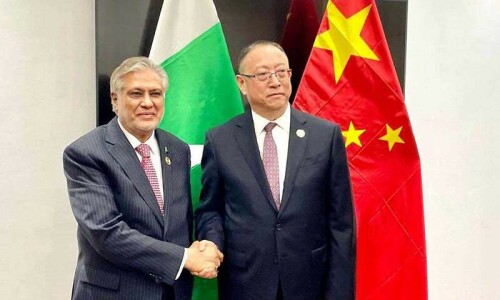Moving with ‘Shehbaz Speed’, the government approved a Circular Debt Management Plan (CDMP) finalised in consultation with multilateral lenders hours after the International Monetary Fund (IMF) released an end-of-mission statement.
At the outset, it took care of the backlog of pending tariff increases on the monthly, quarterly and permanent national average rate of electricity along with a future roadmap covering almost Rs1 trillion (precisely estimated at Rs952 billion) for the current fiscal year.
Other prior actions, including Rs170bn worth of mini-budget involving revenue measures, increase in natural gas tariff, and monetary adjustments, are to follow almost at the same pace.
The most important factor of the recent dialogue between the IMF and the government team has been the trust deficit on the back of repeated violations of committed policy actions. These were not simple slippages against targets that could have been condoned with waivers. The credibility gap required upfront implementation of decisions. No mercy.
Despite swift and heavy price doze to the consumers, the CDMP remains highly vulnerable to a series of variables to the extent that the IMF and the World Bank pushed for reducing the additional government subsidy from Rs675bn on January 28th to Rs336bn on February 9th, 2023.
A 1pc change in the exchange rate has a fiscal impact of Rs5bn in the power invoice, and the exchange rate assumed in the plan is Rs232 against the prevailing rate of above Rs268
For example, only a one per cent change in the exchange rate has a fiscal impact of Rs5bn in the power invoice, and the exchange rate assumed for CDMP is Rs232 per US dollar against the prevailing rate of well above Rs268 per US dollar.
The government concedes that the uncertainty of the assumptions-set developed for CDMP had implications for forecasting accuracy. “Fuel price volatility, economic parameter variation, resource availability, change in commercial operations date of upcoming power plants etc, represent major sources of uncertainty.
Similarly, changes in demand, consumer mix, generation mix, Karachi inter-bank offer rate, local inflation, imported coal price, LNG and crude oil prices have major implications on power purchase cost” and hence would need a continuous process for accurate monitoring.
No wonder it is officially estimated that circular debt closed at Rs2.253tr at the end of June 2022. It will end up increasing to Rs2.374tr, up Rs121bn, despite planned tariff adjustments of about Rs315bn, an additional subsidy of Rs335bn and stock clearance of Rs180bn.
The moving goalposts can also be gauged from the fact that payables to the independent power producers (IPPs) also increased from Rs1.248tr on January 28th to Rs1.510tr on February 8th — in a matter of just 10 days at the rate of about Rs26bn per day.
Besides tariff increases for other sectors, subsidy packages for Zero-Rated Industry (ZRI) and Kissan Package have been approved to be discontinued with effect from March 1st, 2023. The ZRI subsidy will thus be cut by Rs51bn against an unbudgeted estimate of Rs120bn.
Another Rs75bn recovery will be ensured through four quarterly tariff adjustments of Rs3.21 per unit for the current and next month, followed by 69 paise per unit in April-May, Rs1.64 per unit in June-August period and then Rs1.98 per unit in September-November.
This is on top of the Rs7.91 per unit increase already notified and implemented in August. The future quarterly tariff adjustments will be passed on automatically to consumers when due without any delay.
The power division contends that circular debt flow was Rs538bn which was reduced to Rs130bn in FY21. In FY22, the flow was negative Rs27bn. The reasons for the flow of circular debt mainly include under-recoveries of ex-Wapda distribution companies (Discos), line losses above regulatory targets, unpaid and unbudgeted subsidies, pending generation costs, non-payment by K-Electric and markups.
Timely tariff increase and reduction in losses by 0.58pc in a year to 16.27pc and timely payment of budgeted subsidies will help stop flows.
At present, almost 85-90pc cost of the end consumer is composed of the generation cost. In a welcome move, the PML-N led government concedes that “targeted investment in the generation sector without accounting for interalia, cost implications, demand growth and target customers, technological advancements, risk and return matrix, non-least cost-based expansion have resulted in the escalation of the cost of electricity to the point where the consumers have started switching on the alternate solutions.”
The CDMP also targets financing the old stock of debt parked in the Power Holding Limited (PHL) — a shell entity of the power division. The total PHL loans stand at Rs800bn ending Jun-2022. To recover the markup portion of the loans amounting Rs246bn, there is already a surcharge of 43 paisa unit levied in the consumer bill but it is considered insufficient to cover markup charges of total loans.
The remaining markup is being paid through electricity generation collection and added to the circular debt. By end-December 2022, around Rs224bn has been paid as interest charges from the electricity generation portion.
The addition in the circular debt due to PHL markup payments from own sources is projected to be around Rs76bn in FY23, which would be recovered from consumers. This is except for non-time of uses domestic consumers having consumption of less than 300 units and private agriculture consumers from March to June 2023 through an additional surcharge of Rs3.39 per unit, which the ECC has also approved on February 10th.
Furthermore, since there is no cash flow to service the principal amount of debt, the government has given an undertaking to the IMF to transfer the principal loans into public debt and finance it through budget allocation in a phased manner, as is the case with normal public debt.
On top of that, the power division claims that K-Electric had stopped paying power purchases from the national grid in 2018-19 as the power purchase agreement expired in 2015. The amount has accumulated to Rs490bn as of December 2022, according to the power division that estimates further build-up of Rs172bn during the current fiscal year. That remains a big challenge to be resolved.
Towards governance challenges, the government has committed to the IMF to hire top management in the power companies through a competitive basis, signing performance contracts with state-run entities and outsourcing feeders and managements of 10 Discos by June 2023. The ministries of finance and power will ensure that the policy matrix committed with the IMF and the World Bank are complied with in true letter and spirit. Fingers crossed.
Published in Dawn, The Business and Finance Weekly, February 13th, 2023












































Dear visitor, the comments section is undergoing an overhaul and will return soon.